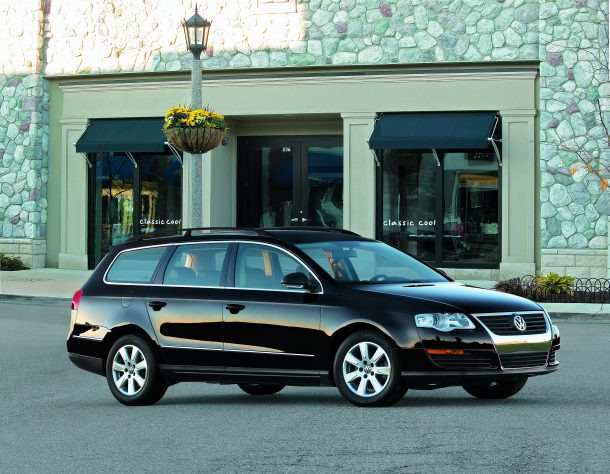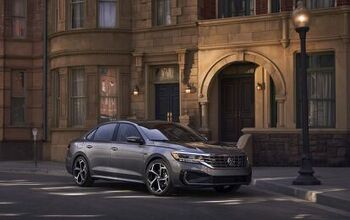Volkswagen Passat Passes Away

The final Volkswagen Passat has rolled off the assembly line in Chattanooga, Tennessee, ending the model’s extended run on the North American market.
Designed by Giorgetto Giugiaro and introduced in 1973 using the VW/Audi B1 platform, the Passat arrived in the United States as the Dasher and was sold as a midsized luxury vehicle to people in the market for an imported economy car. The model carried different names in other parts of the world and even saw a few unique monikers used in the U.S. (e.g. Quantum) to help differentiate between the hatchback, sedan, and wagon variants sold throughout the 1980s. But it was officially known as the (B2) Passat by 1990, regardless of format.
Base models came equipped with a transversely mounted 1.6-liter outputting a rather meager (albeit acceptable for the time) 71 horsepower. Customers could opt for the VR6’s narrow-angle 2.8-liter unit, offering 172 hp and a top speed of 139 mph. Though most purchased versions are equipped with 1.8 or 2.0-liter engines, with Europeans being partial to the diesel variants.
Sales pitched up after the facelifted B4 model hit the scene in 1993 and continued to rise once the B5 resumed platform sharing with Audi in 1997. The model became an upscale option once again, proved by Volkswagen’s decision to begin offering versions with a 4.0-liter W8 late in its lifecycle. However, the majority of fifth-gen models came equipped with four or six-cylinder motors and front-wheel drive, though all-wheel drive remained available throughout most of the B5’s lifespan.
U.S. volume peaked in 2012 with 117,023 deliveries after the B6 had been retired. But it might not be a totally fair assessment because that was also the year holdover models were being sold alongside the larger Passat “New Midsize Sedan” designed specifically to cater to North American and Chinese customers. While the initial reception was positive, sales began to taper off and VW started offering fewer ways to configure the model. Thanks to the internet, Americans had also become aware that the smaller, European-market Passat came with glitzier options and a higher price.
By the end, the manufacturer was only offering the facelifted North American Passat with the default 2.0-liter TSI (174 hp) and six-speed automatic while China got an entirely new model. In 2021, Volkswagen reported it only managed to move 24,396 units inside the United States. China sold 124,402 examples — making it easy to see the company opted to pull the Passat from one market and not the other.
VW mourned the loss of its midsized mainstay this week as executives publicly suggested it was for the best.
“Volkswagen is in the business of making memories, and for 50 years nearly two million Volkswagen owners made memories behind the wheel of a Passat,” stated Scott Keogh, President and CEO, Volkswagen Group of America. “For the thousands of our workers in Chattanooga, that is what makes their job special. And as we look to the future, with the Atlas and Atlas Cross Sport in high demand, and the assembly launch of our all-electric ID.4 SUV coming later this year, they’re ready to help America make millions more of those memories.”
[Images: Volkswagen Group]

A staunch consumer advocate tracking industry trends and regulation. Before joining TTAC, Matt spent a decade working for marketing and research firms based in NYC. Clients included several of the world’s largest automakers, global tire brands, and aftermarket part suppliers. Dissatisfied with the corporate world and resentful of having to wear suits everyday, he pivoted to writing about cars. Since then, that man has become an ardent supporter of the right-to-repair movement, been interviewed on the auto industry by national radio broadcasts, driven more rental cars than anyone ever should, participated in amateur rallying events, and received the requisite minimum training as sanctioned by the SCCA. Handy with a wrench, Matt grew up surrounded by Detroit auto workers and managed to get a pizza delivery job before he was legally eligible. He later found himself driving box trucks through Manhattan, guaranteeing future sympathy for actual truckers. He continues to conduct research pertaining to the automotive sector as an independent contractor and has since moved back to his native Michigan, closer to where the cars are born. A contrarian, Matt claims to prefer understeer — stating that front and all-wheel drive vehicles cater best to his driving style.
More by Matt Posky
Latest Car Reviews
Read moreLatest Product Reviews
Read moreRecent Comments
- SCE to AUX All that lift makes for an easy rollover of your $70k truck.
- SCE to AUX My son cross-shopped the RAV4 and Model Y, then bought the Y. To their surprise, they hated the RAV4.
- SCE to AUX I'm already driving the cheap EV (19 Ioniq EV).$30k MSRP in late 2018, $23k after subsidy at lease (no tax hassle)$549/year insurance$40 in electricity to drive 1000 miles/month66k miles, no range lossAffordable 16" tiresVirtually no maintenance expensesHyundai (for example) has dramatically cut prices on their EVs, so you can get a 361-mile Ioniq 6 in the high 30s right now.But ask me if I'd go to the Subaru brand if one was affordable, and the answer is no.
- David Murilee Martin, These Toyota Vans were absolute garbage. As the labor even basic service cost 400% as much as servicing a VW Vanagon or American minivan. A skilled Toyota tech would take about 2.5 hours just to change the air cleaner. Also they also broke often, as they overheated and warped the engine and boiled the automatic transmission...
- Marcr My wife and I mostly work from home (or use public transit), the kid is grown, and we no longer do road trips of more than 150 miles or so. Our one car mostly gets used for local errands and the occasional airport pickup. The first non-Tesla, non-Mini, non-Fiat, non-Kia/Hyundai, non-GM (I do have my biases) small fun-to-drive hatchback EV with 200+ mile range, instrument display behind the wheel where it belongs and actual knobs for oft-used functions for under $35K will get our money. What we really want is a proper 21st century equivalent of the original Honda Civic. The Volvo EX30 is close and may end up being the compromise choice.







































Comments
Join the conversation
Mustang II outsold S550. Double. In two less years.
Aside from a head gasket failure that occurred under warranty, our ‘00 B5 was a solid performer for the 12 years we owned it. A teenager down the street drive it another two years before putting into a ditch, where it met it’s demise.